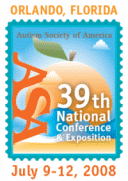 |
The ASA's 39th National Conference on Autism Spectrum Disorders of ASAThe Westin Kierland Resort & Spa, Scottsdale, AZ |
| For a complete author index with session numbers, please click here | |
| Thursday, July 10, 2008: 4:00 PM-5:15 PM | |||
| Miami 1 | |||
| #3626- Increasing Motivation in Individuals with Autism by Accurately Identifying Preferences and Reinforcers (1.5 BCBA continuing education units available) | |||
| One goal for individuals with autism is that their behavior is controlled by its natural consequences, and not by “contrived” or “artificial” reinforcers that are delivered by another person. Yet, many individuals are not intrinsically motivated by learning or working, and require additional reinforcers to maintain performance. This presentation will focus on how to maximize motivation by accurately identifying preferences and reinforcers in individuals with autism, and how allowing choice can have beneficial effects for individuals with autism. | |||
| Presenter: | - Richard B. Graff, MS, BCBA, is a Program Director at the New England Center for Children. Rick has been involved in 120 presentations, is an author/co-author on two book chapters and 20 research articles, and serves on the Editorial Boards of The Journal of Applied Behavior Analysis and Behavioral Interventions. | ||
|
| |||
|
One goal that parents and caregivers often have for individuals with autism is that their behavior is controlled by “natural consequences”, and not by “contrived” or “artificial” reinforcers that are delivered by another person. However, many individuals are not “intrinsically” motivated to learn or work, and in these cases, additional reinforcers are required to maintain performance. For example, many of us are not intrinsically motivated to go to work each day; we need our paychecks to maintain our going to work behavior. Although we may not think of our paycheck as a reinforcer, the paycheck motivates us—in terms of our going to work behavior, the paycheck is likely one of the main reasons why we continue to work! Many people have negative connotations about using reinforcement with individuals with autism, but we know that for some people, this is necessary—just as our paychecks are necessary for most of us to continue working! This presentation will begin by reviewing the concept of motivation, which will be discussed in terms of the contingencies in place for responding – in other words, what the "reasons" are for individuals to behave the way they do. This discussion also involves the concepts of preference and reinforcement. Preference can be thought of simply as what a person likes or enjoys, while reinforcement refers to providing a consequence for a behavior that increases or maintains the frequency of that behavior (e.g., your paycheck is the consequence that maintains your going to work behavior). Although we all have things that we prefer, not all highly preferred items serve as reinforcers for all responses. For example, you may prefer chocolate, but if your paycheck was replaced by chocolate, the chocolate would likely be insufficient to maintain your going to work behavior. For all of us, reinforcement is crucial for maintaining behavior and learning new skills. Unfortunately, it is often difficult to identify the most potent reinforcers for individuals with autism. In general, the more potent a reinforcer is, the better the performance of the individual. Thus, in order to maximize learning or work performance, it is important to identify and use an individual’s most potent reinforcers. Most practitioners working with individuals with autism identify preferences by asking parents and caregiver what the individual prefers. However, several studies have demonstrated that these methods are generally inaccurate. Over the past 20 years, there has been a great deal of published literature on developing techniques to identify efficient and effective reinforcers for individuals with autism. Research has demonstrated that conducting systematic preference assessments is the most effective way to identify potential reinforcers for individuals with autism. The majority of this presentation will focus on describing the techniques that have been validated to accurately identify preferences. The presentation also reviews practical issues related to assessing preferences, such as how often preferences may change, and how motivating operations may influence preference assessment outcomes. Also, we will discuss how to empirically determine if an item truly functions as a reinforcer. Finally, the importance of allowing choice for individuals with autism will be reviewed, and this presentation will provide information regarding several different ways that choice can be incorporated into the daily lives of individuals with autism. |
|||
See more of Continuing Education Sessions
See more of The ASA's 39th National Conference on Autism Spectrum Disorders